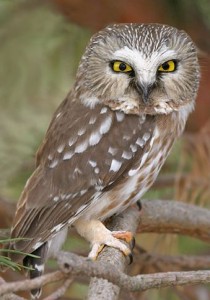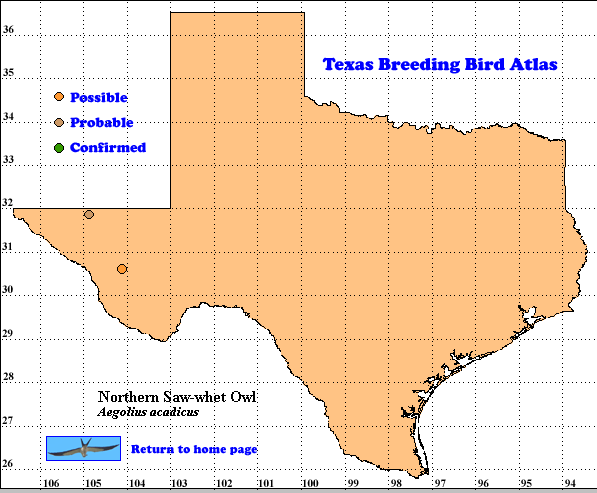This small, sexually dimorphic owl (male about 75 g [2.7 oz], female 100g [3.6 oz]) has a heavy coat of soft body feathers, giving it the feel of a plush toy. It is a nocturnal feeder, catching small rodents by a combination of hearing and night vision. Its name comes from the resemblance of one of its vocalizations to the sound of a file sharpening a saw.
DISTRIBUTION. During the field work for the TBBA project in 1987-1992, researchers found 1 probable and 1 possible breeding record in latilong 31104 (Guadalupe Mountains) and 1 possible in 30104 (Davis Mountains). These observations are consistent with Lockwood and Freeman’s (2004) report of the species as a very rare summer resident of the Guadalupes and possibly Davis mountains. Oberholser’s (1974) only summer record was of breeding in the Guadalupes.
In other states and provinces this owl breeds from southern Alaska and western British Columbia east across southern Canada to Nova Scotia, the northeastern United States and the Appalachian Mountains. In the west breeding continues south through the mountains to southern California, southeast Arizona and southern New Mexico.
In Mexico, the species is present all year at elevation between 1800 and 3500 m (6000 to 11,500 ft) south to the Isthmus of Tehuantepec (Howell and Webb 1995).
Seasonal movements of this species need further study. Some of the northern breeding population move south in the fall and return in the spring. The percentage of the population which moves is unknown, although apparently sizable. Studies have found about 70% of southbound migrants are first year birds and females are the predominant sex (Grigg 1991, 1992; Cannings 1993; Priestley and Priestley 2005).
SEASONAL OCCURRENCE.Lockwood and Freeman (2004).list Northern Saw-whet Owl as a summer resident with scattered winter records in the Trans-Pecos and High Plains regions.
BREEDING HABITAT. Across the breeding range of Northern Saw-whet Owl, population densities are highest in coniferous forests, although breeding also occurs in most forest and woodland habitat. In Colorado the four most common habitat types used by this owl are upland conifer forest (23%), pinyon-juniper woodland (21%), ponderosa pine woodland(19%) and upland deciduous forest (9%: Boyle 1998). In Arizona 54% of breeding records came from mixed coniferous forest with Douglas fir and ponderosa pine. Other breeding records were spread among 5 other montane habitat types (Wise-Gervais 2005). In Mexico this owl is resident in humid to semihumid pine, fir and pine-oak forests (Howell and Webb 1995).
Northern Saw-whet Owls usually nest in old woodpecker cavities, often those of Northern Flicker (Colaptes auratus) or Pileated Woodpecker (Dryocopus pileatus) with entrance hole diameters of 62-75 mm (2.5-3 in). Nest boxes with entrance hole diameters of 75 mm and floors 17.5 x 17.5 cm (7 x 7 in) are readily used. Cleaned nest boxes may be used in a successive year by a different pair (Cannings 1993).
The female typically lays 5-6 (range 4-7) smooth, white eggs at 2-day intervals. She begins incubation after laying the first egg and the eggs hatch after 27-29 days of incubation.. She broods the nestlings until the youngest is about 18 days old. The male provides food for the female and nestlings since the beginning of incubation. She leaves the nest to roost elsewhere at the end of brooding. The young birds leave the cavity 1-2 days apart and are then fed by their parents for about a month (Cannings 1993).
STATUS. Lockwood and Freeman (2004) characterize Northern Saw-whet Owl as a very rare summer resident in the Guadalupe (and,possibly Davis) mountains of Trans-Pecos, Texas. The Breeding Bird Survey does not sample this nocturnal owl anywhere in its range. Cannings (1993) assumes an average density of 1 individual/km2 (0.4 mi2) across its total range.
Text by Robert C. Tweit (2006).
Literature cited.
Boyle, S. 1998. Northern Saw-whet Owl (Aegolius acadicus). In Colorado breeding bird atlas, pp. 230-231 (H. E. Kingery, ed.), Colorado Bird Atlas Partnership, Denver.
Cannings, R. J. 1993. Northern Saw-whet Owl (Aegolius acadicus). In The birds of North America, No. 42 (A. Poole and F. Gill, eds.). The Birds of North America, Inc., Philadelphia, PA.
Grigg, W.N. 1991. Spring owl banding at the Whitefish Bay Bird Observatory, Michigan from 1981-1990. Part 2, recaptures and returns. N. Am. Bird Bander 16: 63-65.
Grigg, W. N. 1992. Spring owl banding at the Whitefish Bay Bird Observatory, Michigan from 1981-1990. N. Am. Bird Bander 17: 16-19.
Howell, S. N. G. and S. Webb. 1995. A guide to the birds of Mexico and northern Central America. Oxford University Press, New York.
Lockwood, M. W. and B. Freeman. 2004. The TOS handbook of Texas birds. Texas A&M University Press, College Station.
Priestley, C. and L. Priestley. 2005. Results of a pilot study monitoring Northern Saw-whet Owl migration in central Alberta, Canada. West. Birds 36: 303-309.
Wise-Gervais, C. 2005.Northern Saw-whet Owl (Aegolius acadicus). In Arizona breeding bird atlas. pp. 228-229 (T. E. Corman and C. Wise-Gervais, eds.), University of New Mexico Press, Albuquerque.

